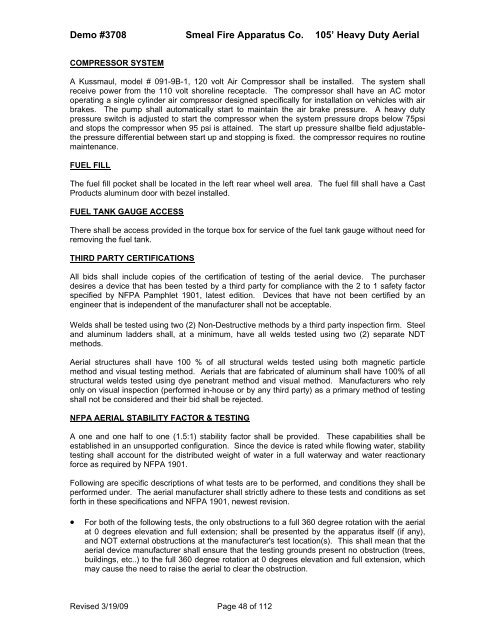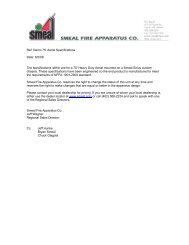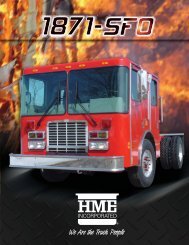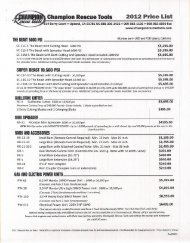Ref: Stock 105' Aerial Specifications - R & R Fire Truck Repair, Inc.
Ref: Stock 105' Aerial Specifications - R & R Fire Truck Repair, Inc.
Ref: Stock 105' Aerial Specifications - R & R Fire Truck Repair, Inc.
You also want an ePaper? Increase the reach of your titles
YUMPU automatically turns print PDFs into web optimized ePapers that Google loves.
Demo #3708 Smeal <strong>Fire</strong> Apparatus Co. 105’ Heavy Duty <strong>Aerial</strong><br />
COMPRESSOR SYSTEM<br />
A Kussmaul, model # 091-9B-1, 120 volt Air Compressor shall be installed. The system shall<br />
receive power from the 110 volt shoreline receptacle. The compressor shall have an AC motor<br />
operating a single cylinder air compressor designed specifically for installation on vehicles with air<br />
brakes. The pump shall automatically start to maintain the air brake pressure. A heavy duty<br />
pressure switch is adjusted to start the compressor when the system pressure drops below 75psi<br />
and stops the compressor when 95 psi is attained. The start up pressure shallbe field adjustablethe<br />
pressure differential between start up and stopping is fixed. the compressor requires no routine<br />
maintenance.<br />
FUEL FILL<br />
The fuel fill pocket shall be located in the left rear wheel well area. The fuel fill shall have a Cast<br />
Products aluminum door with bezel installed.<br />
FUEL TANK GAUGE ACCESS<br />
There shall be access provided in the torque box for service of the fuel tank gauge without need for<br />
removing the fuel tank.<br />
THIRD PARTY CERTIFICATIONS<br />
All bids shall include copies of the certification of testing of the aerial device. The purchaser<br />
desires a device that has been tested by a third party for compliance with the 2 to 1 safety factor<br />
specified by NFPA Pamphlet 1901, latest edition. Devices that have not been certified by an<br />
engineer that is independent of the manufacturer shall not be acceptable.<br />
Welds shall be tested using two (2) Non-Destructive methods by a third party inspection firm. Steel<br />
and aluminum ladders shall, at a minimum, have all welds tested using two (2) separate NDT<br />
methods.<br />
<strong>Aerial</strong> structures shall have 100 % of all structural welds tested using both magnetic particle<br />
method and visual testing method. <strong>Aerial</strong>s that are fabricated of aluminum shall have 100% of all<br />
structural welds tested using dye penetrant method and visual method. Manufacturers who rely<br />
only on visual inspection (performed in-house or by any third party) as a primary method of testing<br />
shall not be considered and their bid shall be rejected.<br />
NFPA AERIAL STABILITY FACTOR & TESTING<br />
A one and one half to one (1.5:1) stability factor shall be provided. These capabilities shall be<br />
established in an unsupported configuration. Since the device is rated while flowing water, stability<br />
testing shall account for the distributed weight of water in a full waterway and water reactionary<br />
force as required by NFPA 1901.<br />
Following are specific descriptions of what tests are to be performed, and conditions they shall be<br />
performed under. The aerial manufacturer shall strictly adhere to these tests and conditions as set<br />
forth in these specifications and NFPA 1901, newest revision.<br />
<br />
For both of the following tests, the only obstructions to a full 360 degree rotation with the aerial<br />
at 0 degrees elevation and full extension; shall be presented by the apparatus itself (if any),<br />
and NOT external obstructions at the manufacturer's test location(s). This shall mean that the<br />
aerial device manufacturer shall ensure that the testing grounds present no obstruction (trees,<br />
buildings, etc..) to the full 360 degree rotation at 0 degrees elevation and full extension, which<br />
may cause the need to raise the aerial to clear the obstruction.<br />
Revised 3/19/09 Page 48 of 112







